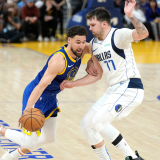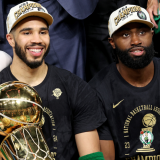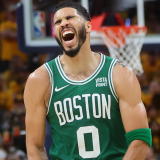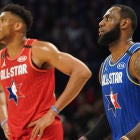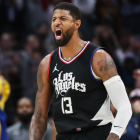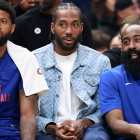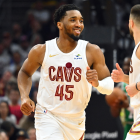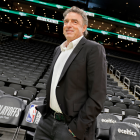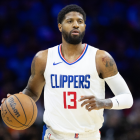The greatest draft class in NBA history was inadvertently produced in 2005. By banning high schoolers from entering the draft, the typical slew of high school stars that should have populated the 2006 class were forced to wait until 2007, whose own high school phenoms needed to wait until 2008, and so on. Future drafts would remain balanced ... so long as high schoolers remained banned. But with the infamous one-and-done rule losing popularity with each passing year, a return to the draft's old eligibility rules is a matter of when, not if. When that happens, one glorious year of overlap will create a draft that includes both the best high schoolers of the year and the last crop of freshman forced into a year of college.
This mythical "double draft" will be an unintended consequence of a rule passed over a decade ago, but if the class is as deep as it figures to be, it could shape the next decade of NBA history after it comes. While the talent at the top of the class would likely be roughly similar to a typical year, the sheer volume of prospects gives teams at the back of the draft a chance to add young talent they wouldn't usually have access to. If there truly is twice as much talent in the class, the team picking No. 30 would expect to find a prospect at the level of a typical No. 15 pick. Both Kawhi Leonard and Giannis Antetokounmpo were taken No. 15 overall. Imagine an existing champion lucking into a player like that because of a decree from 2005. That's hardly ideal for competitive balance.
And yet, on its current course, the NBA is barreling towards exactly such a problem ... but without the 15-year lag. As the coronavirus hiatus reshapes the league's short-term finances and virtually guarantees either a cap freeze or even decline, free-agent movement in 2020 will likely grind to a halt. This has the potential to create something even more dangerous to competitive balance than a double draft: something akin to a double free-agent class, and it could come as soon as 2021.
Free agency was going to be slow in the 2020 offseason even before the coronavirus outbreak. Under original 2020-21 cap projections, only seven teams were expected to have meaningful cap space. Among those teams, Cleveland and New York will likely lose some of that space to contract options, while Phoenix's space relies on jettisoning breakout center Aron Baynes. There was a very real scenario in which only Atlanta, Miami, Charlotte and Detroit operated as below-the-cap teams this offseason even before this pandemic. The fallout from months of lost games is going to cut into that available space significantly.
A lack of space creates a lack of leverage. A player's original team, in most cases, is free to exceed the salary cap to retain a player, but the only motivation to pay that player market value is the knowledge that, in a normal year, if they don't, someone with cap space can. That competition isn't going to be present this offseason, though, incentivizing teams to low-ball their own free agents. Players have little recourse in an immediate sense, but can wait for more favorable market conditions down the line.
Broadly, this is what happened in the summers leading up to 2016's cap spike. A number of players knew that the league's new TV deal was going to push the cap to unfathomable heights, so rather than sign long-term deals in 2014 or 2015, they attempted to time their free agencies with that spike so that they could cash in when it came. LeBron James was by far the most famous player to do so, signing one-year deals in 2014 and 2015 with an eye on that TV money, but other top free agents like Greg Monroe and Paul Millsap took short-term contracts with player-options for that exact purpose. A number of lower-level players followed suit.
Fortunately for the league and the players, the cap jump was so enormous that players still wound up being vastly overpaid. The same won't be the case next year. The cap isn't jumping 25 percent in 2021. There will be plenty of space. After all, teams have been planning a 2021 splurge for years now, and with Giannis, Kawhi, Paul George, Rudy Gobert, Victor Oladipo and Jrue Holiday all potentially hitting the market, it's not hard to see why. But no amount of planning could create an environment comparable to 2016's, let alone do so in the aftermath of a pandemic.
But the talent available has the potential to be utterly historic. Assume that market conditions really do scare the top players of 2020 into waiting. Seven of our top 14 free agents have player options. While Anthony Davis is going to get paid no matter what, players like Gordon Hayward, DeMar DeRozan and Evan Fournier might decide to stay put and try their luck again a year from now. Restricted free agents like Bogdan Bogdanovic and Dario Saric could bet on themselves and take a one-year qualifying offer that would get them onto the unrestricted market in 2021 if their own teams don't step up with worthwhile offers.
And then there are the circumstantial cases, the teams and veterans that were destined for short-term contracts anyway. Derrick Favors in New Orleans is a perfect example. He is essential to their team. The Pelicans outscore opponents by 5.8 points per 100 possessions with him on the floor, the best figure of any player on their team not named Zion Williamson by a mile. They also just spent a lottery pick on a player at his position in Jaxson Hayes who has shown promise. New Orleans wants to win right away. They won't commit to Favors long term with Hayes in the pipeline. Favors would have received strong offers in a normal offseason. But now? A short-term pact may be all that's on the table outside of the mid-level exception.
Some of these players are going to get paid in 2020. Most of them won't, and history says that they will cycle back onto the market in 2021, when there was already a group of free agents widely considered to be among the best ever ready to ply their wares. Without an enormous cap spike to absorb that talent, some of it is inevitably going to fall through the cracks. The cap space will dry up before the talent pool does, and that will force unusually valuable players to rely on other factors in making their decisions. With money being equal, market and winning become two of the strongest remaining draws.
The enduring memory of 2016's free-agent bonanza is Kevin Durant bolting for Golden State, but an ominous footnote of that move was the Zaza Pachulia signing that followed it. The Warriors managed to bring in a starting-caliber center for peanuts because he was one of the few players that missed out on the fortunes of that summer. When his options dried up, he gave the Warriors, the best team in the NBA, a player they shouldn't have had access to.
This could be the norm in 2021. Imagine Giannis forming a new superteam that snaps up all of the role players it needs for pennies on the dollars, or a Lakers or Clippers team coming off of a championship using their mid-level exception to add a player that, in a normal offseason, might score an enormous contract.
These are the outcomes facing the NBA as coronavirus leaves its indelible mark on professional sports. There are steps that the league could take to avert this sort of crisis. Stimulating spending in 2020 is the first, critical step that needs to be taken. Building an amnesty clause into whatever their ultimate cap compromise winds up being would be a good start. But in the league's current financial state, there might be no avoiding what's coming. One of the best free-agent classes in recent memory is going to get a whole lot better, and the teams that benefit from that will be the ones that need it least.






